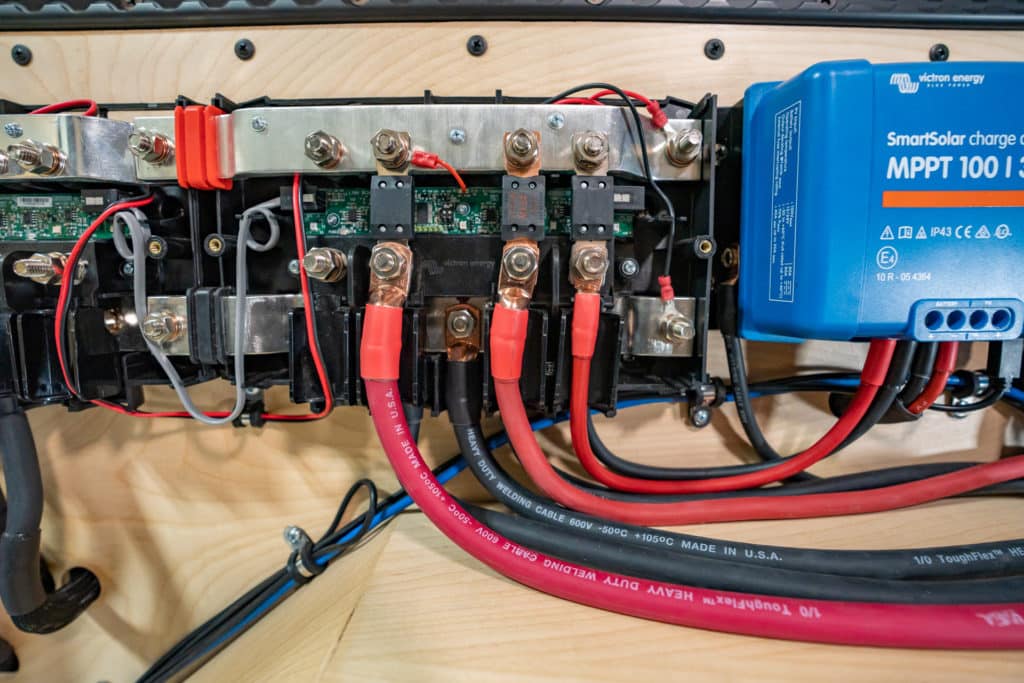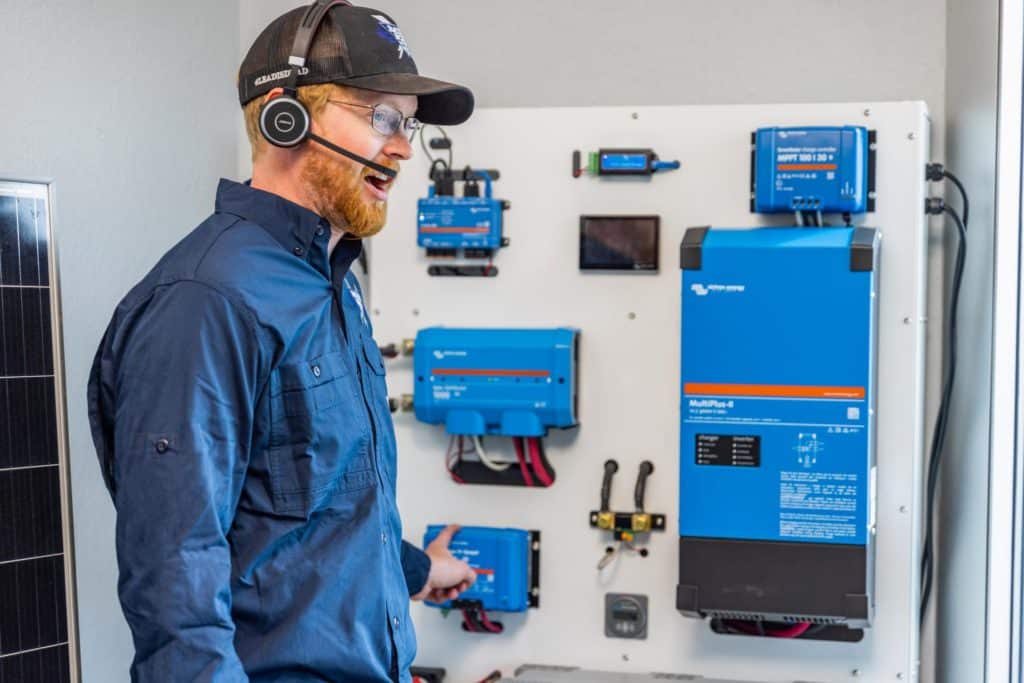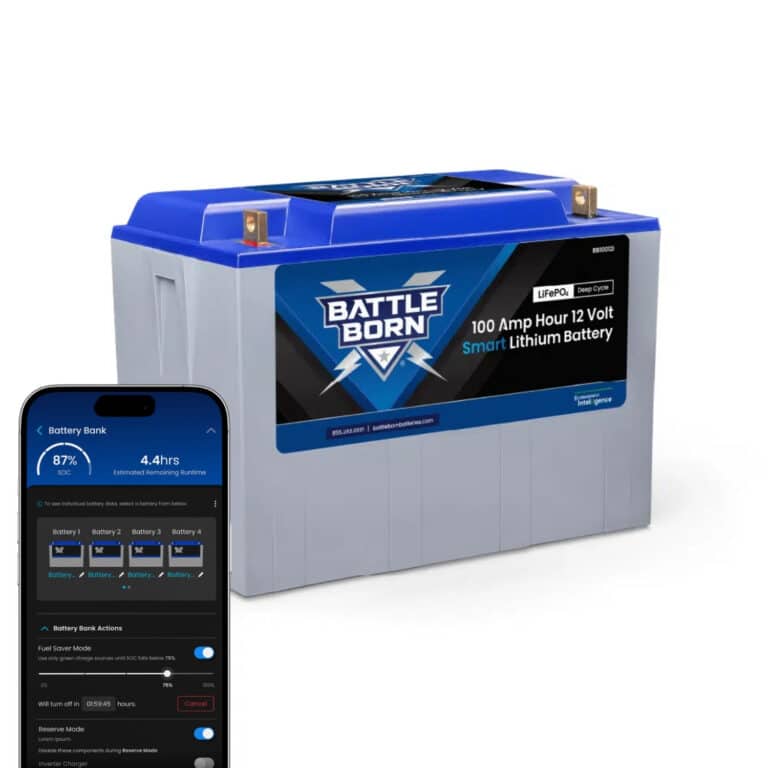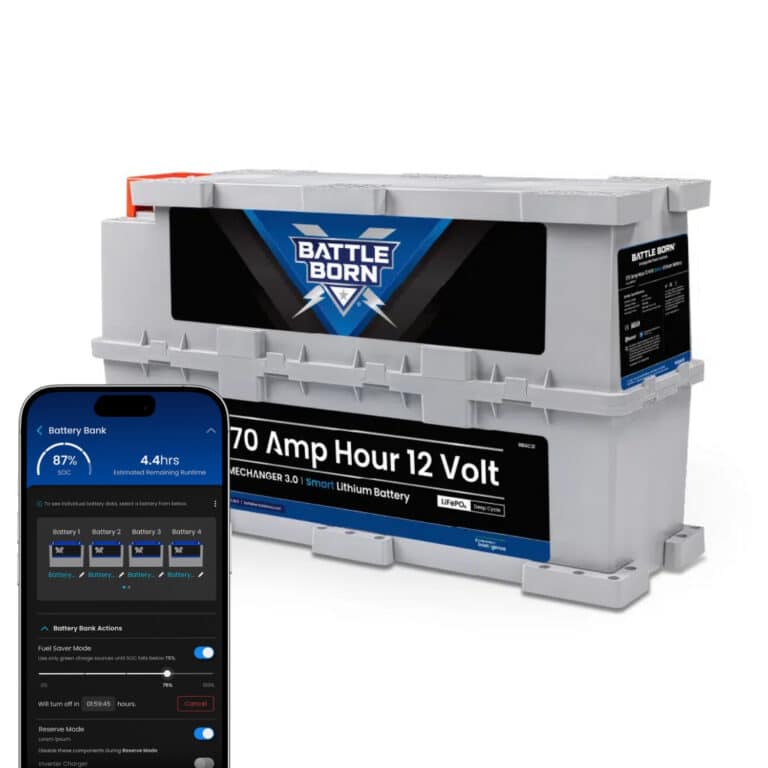
MENUMENU
TALK TO AN EXPERT
Special Hours: 7AM – 6PM PST
TALK TO AN EXPERT
Special Hours: 7AM – 6PM PST
If you’re experiencing issues with your lithium battery not charging, there are a few easy troubleshooting tips you can try. Let’s dive in and see what might be causing your power problems and what you can do about it.
Lithium batteries require a BMS (battery management system) to monitor the status of the batteries. This vital piece of equipment helps ensure that the batteries only charge when the conditions are safe for charging. No matter how you’re charging your lithium batteries, the BMS should prevent charging when temps are below freezing, unless the batteries are heated.
Because lithium batteries can charge quickly and efficiently without long absorption charge requirements, many owners choose to use solar panels to charge their lithium batteries. However, you can also charge through a vehicle alternator or shore power. Depending on the size of your battery bank, you can save hours of charging time by choosing lithium batteries over lead-acid options.
Unfortunately, if your lithium battery is not charging, several things could be causing the issue. The troubles could range from a damaged battery to external complications that have nothing to do with your lithium battery. It will take some trial and error and a bit of troubleshooting to get to the root of the problem.
If you’re experiencing issues with your lithium batteries, here are a handful of things you should check first. These are some of the easiest and most common places to start, and just about anybody can check them.
The most common cause of a battery bank not charging is that the charger itself has quit charging. This could be due to a simple switch or fuse, or as complicated as a damaged charger. Before going further in your diagnostics, make sure your charging source is working. Here are some areas to check for the major charging types.
These need power from the grid, so make sure the breaker is not tripped and the unit has power. Check that the switch is on, and if it has a remote panel or switch, check that it is on as well. Sometimes these units also need to be programmed for the appropriate battery, so be sure it’s properly programmed.
Ensure the panels receive full sunlight and connect properly to the charge controller. Inspect any fuses or breakers linked to the controller, and if it includes a display or smart interface, confirm that charging is enabled.
Most of the time, an alternator charge controller or DC-DC controller sits between the alternator and the batteries. This unit detects when an engine is running and starts charging. Settings on these units can be complicated, but you need to make sure the voltages are set correctly for the vehicle and battery bank it’s charging. These systems should also include a plug, fuse, or switch to turn them on and off, so check that they are properly connected.
Generator charging for lithium batteries usually uses the same charger as shore power. If your batteries charge fine on shore power but not from the generator, the automatic transfer switch is likely the issue.
Check that the generator’s breaker hasn’t tripped and that all connections are secure, especially on portable units. In some cases, the charger may reject the generator’s power output. For example, on Victron chargers, you may need to enable the “Weak AC Input” or “Enable Weak AC Charging” setting to allow proper charging.
If you’re unsure whether your charger is working, you will need to try using a multimeter to test it, and we will discuss that a little further down.
One important and easy thing to check when your lithium battery isn’t charging is your connections. Simply wiggle the wires and look for any loose connections that need tightening. This includes the connections to the battery and any other connections in your electrical system to your charging infrastructure.
It might surprise you that a slightly loose connection can cause problems, including problems charging your batteries. Tighten loose connections and test your system again to see if that fixes your problems.

If everything seems okay so far, but you’re still unsure whether your charger is working, the next step is to measure what’s actually happening in the system. A clamp-on ammeter and voltmeter are the safest and easiest tools to use here. They let you check both voltage and current without disconnecting wires.
By combining these voltage and current checks, you can quickly narrow down whether the charger, the wiring, or the battery bank is at fault. If the batteries are getting a higher charge voltage but not charging, it is most likely the BMS inside the battery that is causing problems and may need professional repair.
Some batteries, including Battle Born batteries, have a low-voltage disconnect feature built into the BMS. This is a safety feature designed to protect your batteries and help ensure they last as long as possible. The low-voltage disconnect mode typically kicks in when a battery reaches 10V, and it’s important that you charge your battery as soon as possible. Within five days is best.
The only way to get a battery out of low-voltage disconnect mode is by resetting it, which means charging it. You’ll need to plug into shore power or alternator power, or get a charge from solar panels. If you can, charge them back up to 100% and allow the batteries to balance all of the cells.
If you just dropped in a lithium battery with your existing electrical system, there’s a good chance your charger is insufficient. Lithium batteries can accept substantially more power compared to other types of batteries. This is why they charge faster.
You may need to upgrade your charger or adjust its settings to accommodate your lithium batteries. Check with the documentation that came with your charger and your batteries to ensure they’re compatible.

When in doubt, give our customer service line a call at (855) 292-2831. Our customer service department has experience in helping troubleshoot battery systems, even over the phone. If we can’t help fix your problem, there’s a good chance we can point you in the right direction of an expert who can.
If a lithium battery has experienced serious damage, the internal BMS won’t allow the battery to do anything. It won’t accept a charge or provide any power. This is a safety mechanism that keeps you, your vehicle, and your family safe from anything that might not be wired right in your rig. That could be why your lithium battery isn’t charging.
You could have permanently damaged your battery if you’ve ever charged or discharged your battery outside of the recommended specifications or if your lithium battery has been in an accident. If you’re experiencing these types of issues, then you’ll want to have your battery inspected to understand the root of the problem. Call us anytime to discuss any Battle Born Battery questions!
A: Start by checking the simple things first. Make sure your solar panels or charger are producing power and connected correctly. Inspect all fuses, breakers, and wiring between the charger and the battery. If you’re charging from a generator, confirm that its breaker isn’t tripped and that your charger recognizes the generator’s AC output.
If all connections check out and the battery still won’t charge, the internal BMS may have entered protection mode. In that case, see the next question.
A: A lithium battery that appears “dead” has often entered low-voltage cutoff mode to protect itself from over-discharge. To “wake it up,” connect it to a compatible charger that can detect and apply a small current even when voltage is low. Many lithium-specific chargers or solar charge controllers will automatically do this.
If your charger doesn’t start charging, briefly connect another charged lithium battery in parallel (positive to positive, negative to negative) to raise the voltage enough for the charger to recognize it. Once charging begins, disconnect the helper battery.
A: Most lithium batteries reset automatically once the BMS detects safe operating conditions again. To help this process:
If your system uses a Victron, Progressive Dynamics, or similar smart charger, make sure lithium charging profiles are selected. For Battle Born Batteries, the BMS will typically reset as soon as charging resumes within safe voltage and temperature limits.
A: In most cases, yes—but only if the cells haven’t fallen below their safe voltage threshold for too long. You can usually revive a lithium battery in protection mode with a proper lithium-compatible charger. However, if it’s been sitting completely discharged for an extended period, permanent cell damage may have occurred.
If your battery won’t recover after attempting a safe wake-up charge, contact the manufacturer or a qualified technician for further evaluation. Never try to force-charge a deeply discharged lithium battery using unregulated power sources.
We know that building or upgrading an electrical system can be overwhelming, so we’re here to help. Our Reno, Nevada-based sales and customer service team is standing by at (855) 292-2831 to take your questions!
Also, join us on Facebook, Instagram, and YouTube to learn more about how lithium battery systems can power your lifestyle, see how others have built their systems, and gain the confidence to get out there and stay out there.
Shop Best Sellers








Ask a technical specialist now at 855.292.2831
Stay in the Know